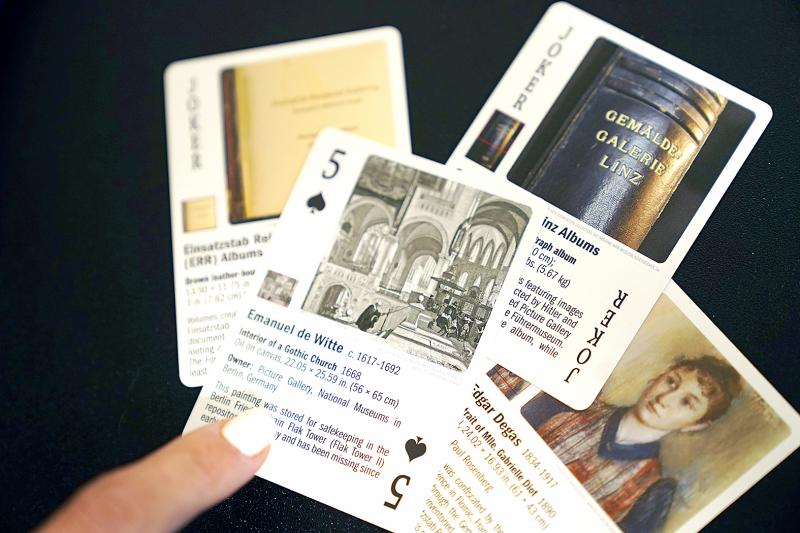A group dedicated to finishing the work of World War II’s Monuments Men is betting on a deck of playing cards — and reward money — to help find missing works of art taken by the Nazis.
Inspired by the US military’s history of creating playing cards related to missions, the Dallas-based Monuments Men Foundation for the Preservation of Art on Wednesday announced the creation of the deck focusing on works — including paintings, sculptures and reliquaries — they believe still exist.
“What is needed is to raise awareness about what is missing,” said Anna Bottinelli, the foundation’s president. “Because you might know of a friend who has a beautiful painting on the wall and you don’t even question that that painting belongs to someone else.”

Photo: AP
The group, which is offering rewards of up to US$25,000 for information leading to the recovery of each cultural object featured in the deck, will highlight a few of the cards each week on their social media.
Bottinelli said the foundation worked with museums, law enforcement and owners of lost art as they narrowed down which works to feature, which include those by Vincent van Gogh, Caravaggio and Claude Monet.
One, a pastel by Edgar Degas titled Portrait of Mlle Gabrielle Diot that was taken by the Nazis from a home in France in 1940, is known to have been sold in the mid-1970s to an unknown Swiss collector.

Photo: AP
“Many of these have resurfaced in the recent past — even as late as 2008 — in auctions,” Bottinelli said.
The deck, being sold through the foundation and the National WWII Museum in New Orleans, is a nod to a US military tradition that includes a deck featuring the most-wanted fugitives from the Iraq War and one from World War II designed to help soldiers identify aircraft, Bottinelli said.
FBI Special Agent Christopher McKeogh, a New York-based member of the agency’s Art Crime Team, said he thinks there’s a misconception that because it’s been nearly 80 years since the end of the war, that most of the missing art has been found.
“There’s still a lot of artwork to still be on the lookout for,” McKeogh said, noting that the Nazi’s looting was “on a scale that is really hard to comprehend.”
McKeogh said that in some cases, people haven’t realized an artwork’s past until taking it to a gallery or an auction house.
“In those cases, we’ll take steps to seize it and hopefully repatriate the artwork,” McKeogh said, adding that once such a history is uncovered, “owners are usually very willing” to have it returned.
“We can never undo the atrocities of the war, but any little thing that we can do to reunite one of these works with the heirs, it’s an important thing,” McKeogh said.
Robert Edsel, founder and chairman of the Monuments Men foundation, said that for those who do realize they own looted art, “this is a chance for people to do the right thing, to come forward, to address the problem.”
Edsel started the foundation in 2007 to honor the Monuments Men, the group of men and women from Allied countries, many with art expertise, who served during World War II to protect cultural treasures as battles waged, and after the war helped return artwork plundered by the Nazis to the rightful owners.
He has written several books on the Monuments Men, including one that the movie The Monuments Men starring and directed by George Clooney was based on.
The foundation gets frequent calls from people wondering about objects from the war, and has over the years helped return more than 30, including a 16th century tapestry taken by a US officer from Adolf Hitler’s Eagle’s Nest retreat near the end of the war. The officer’s family gave the tapestry to a German museum in 2016.
In addition to the 52 works of art in the deck, two cards — the jokers — each feature a set of Nazi photo albums of artwork which have missing volumes.
There’s reason to hope someone might come across one: The foundation has already found five that had been brought home by US soldiers after the war as souvenirs.
“It has always been a joy for us to see how much gratitude there was on both parties: The party that was returning something and the party that was receiving,” Bottinelli said.

On April 26, The Lancet published a letter from two doctors at Taichung-based China Medical University Hospital (CMUH) warning that “Taiwan’s Health Care System is on the Brink of Collapse.” The authors said that “Years of policy inaction and mismanagement of resources have led to the National Health Insurance system operating under unsustainable conditions.” The pushback was immediate. Errors in the paper were quickly identified and publicized, to discredit the authors (the hospital apologized). CNA reported that CMUH said the letter described Taiwan in 2021 as having 62 nurses per 10,000 people, when the correct number was 78 nurses per 10,000

As we live longer, our risk of cognitive impairment is increasing. How can we delay the onset of symptoms? Do we have to give up every indulgence or can small changes make a difference? We asked neurologists for tips on how to keep our brains healthy for life. TAKE CARE OF YOUR HEALTH “All of the sensible things that apply to bodily health apply to brain health,” says Suzanne O’Sullivan, a consultant in neurology at the National Hospital for Neurology and Neurosurgery in London, and the author of The Age of Diagnosis. “When you’re 20, you can get away with absolute

When the South Vietnamese capital of Saigon fell to the North Vietnamese forces 50 years ago this week, it prompted a mass exodus of some 2 million people — hundreds of thousands fleeing perilously on small boats across open water to escape the communist regime. Many ultimately settled in Southern California’s Orange County in an area now known as “Little Saigon,” not far from Marine Corps Base Camp Pendleton, where the first refugees were airlifted upon reaching the US. The diaspora now also has significant populations in Virginia, Texas and Washington state, as well as in countries including France and Australia.

May 5 to May 11 What started out as friction between Taiwanese students at Taichung First High School and a Japanese head cook escalated dramatically over the first two weeks of May 1927. It began on April 30 when the cook’s wife knew that lotus starch used in that night’s dinner had rat feces in it, but failed to inform staff until the meal was already prepared. The students believed that her silence was intentional, and filed a complaint. The school’s Japanese administrators sided with the cook’s family, dismissing the students as troublemakers and clamping down on their freedoms — with